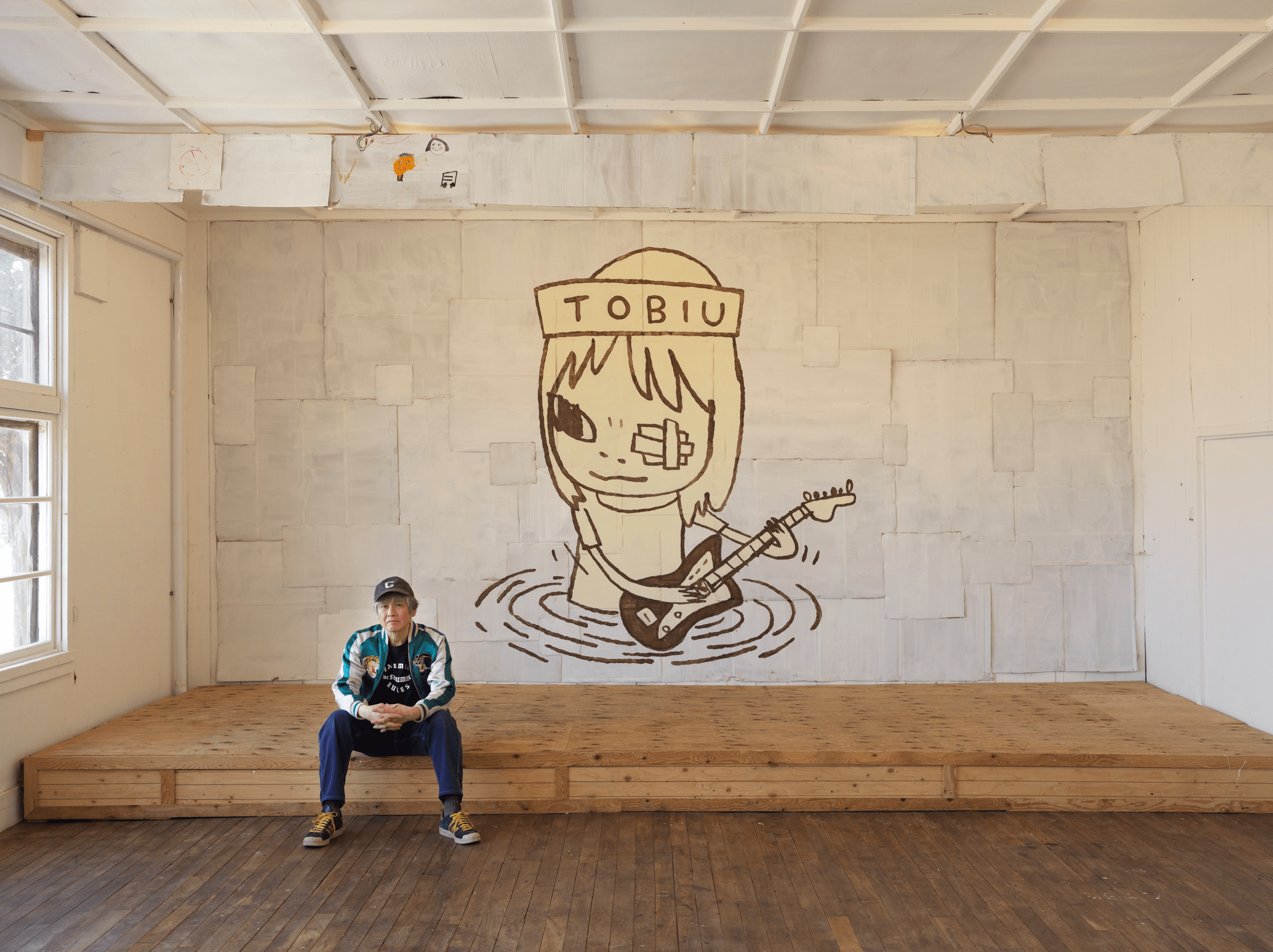What a soundtrack is to a movie, a Spotify list is to the new non-chronological retrospective of Japanese artist Yoshitomo Nara now on view at Guggenheim Bilbao: it reveals the mood underpinning the visual landscape. Amongst the 25 tracks Nara selected are tunes from T.Rex, Big Star, Donovan and—in a nod to the national setting—two references to Spain’s countercultural La Movida, in the form of Radio Futura’s Enamorado de la moda juvenil and Tequila’s Salta!!!
“I don’t listen to music in order to draw something,” the artist said in a conversation with curator Mika Yoshitake in 2020, timed with his exhibition at LACMA. “When I’m listening, I see an image and I try to capture it.” He built himself a radio as a child and tuned into broadcasts by the American military stationed in Japan during the Vietnam War. He began going to record shops in middle school. He’s cited Bob Dylan and Neil Young as permanent auditory staples. The New York Times described him as an “insatiable witness to Western pop’s evolution from the flower-child bliss of the mid-60s to the ecstatic thrash of late ’70s punk.” But although many works in the show are named after songs—and a charming dual representation of Dee Dee and Joey Ramone is on view, as musician dogs mid-performance—the music is often sublimated.

“The Nara that we know now, it is the Nara that started in Germany while he was a student at the Kunstakademie,” Lucia Aguirre, curator of the Bilbao show, said. Born in Japan after World War II, Nara went to Germany to study in 1988, after he had been to Documenta in Kassel the year prior. Although he’d already completed a university degree in Japan, he decided to start over. He has stated Japan’s educational system was tinged by a ‘do what you’re told’ approach; he transitioned willingly to Europe’s ‘make up your own mind’ approach. At the Kunstakademie in Düsseldorf, he studied under the Neo-Expressionist A. R. Penck; other teachers working at the same time included the Bechers and Gerhard Richter. “The problem that he had, of not speaking German when he arrived, made him think about his art as a way to communicate with others.” In 1994, after his studies ended, he moved to Cologne and lived in a collective in a Bauhaus building, remaining there until he had a show at the Yokohama Museum of Art in Japan in 2001, a point at which he decided to return to his native land.

Nara works alone, without studio assistants. He often paints on recycled cardboard boxes, window frames, and used envelopes. “He approaches the canvas without doing any sketching; he’s using the canvas as a laboratory itself,” Aguirre said of Nara’s process. He has collaborated with designer Stella McCartney on two capsule collections of Oxford shirts and shorts. His Knife Behind Back (2000) sold at Sotheby’s for $25 million in Hong Kong; ARTnews called him “one of the most expensive artists in Asia, and his work regularly appears in marquee auctions there.”
His signature Nara girls—some more androgynous than evoking any firm gender identity—are readily distinguishable by their oversized heads, their reductively delineated bodies, and their giant eyes “that are like orange slices,” Aguirre noted. These impish creatures are painted shadowlessly against featureless backgrounds, as was done in the early Renaissance or pre-Renaissance, Aguirre pointed out.

“His sense of humor is so developed in his drawings,” Aguirre said. Indeed, there is something amusing and sly about these devious creatures. In one reproduction of a typical ukiyo-e woodblock print, a geisha peers over a Nara girl scowling from within a teacup. Of this delightfully interventionist work, it’s like he’s “changing the history of art a little bit.”
SEE ALSO: Rich Tapestries and Loose Ends – ‘Woven Histories’ Is Unwieldy in Its Comprehensiveness
His work underwent a sharp tonal change, however, after the Tohoku earthquake and resulting tsunami of 2011. Many thousands of people were killed, creating an unfathomable sense of loss. For a while, Nara stopped producing. When he did start again, the tenor and style of his work had changed. Aguirre cited Miss Margaret (2016) as a prime example of a new approach: layered surfaces, variegated color use and a new articulation of the eyes in a tremulously melancholic gaze. This has continued all the way through Midnight Tears (2023), the most recent work in the show, with its softened, motley portrayal of a mournful figure. What remains the same throughout, per Aguirre: “the face of the girl, in the center, like a moon in the middle of the canvas.”

This show at Guggenheim Bilbao is Nara’s first big exhibition in Europe. After its run in the U.S. at LACMA, the exhibition traveled to the Yuz Museum in Shanghai; following its time at the Guggenheim Bilbao in Spain, the show will move to the Kunsthal Rotterdam in the Netherlands. As for why Nara’s presence in Europe hasn’t been very notable, despite his twelve-year stint on the continent, Aguirre was unsure about what accounts for this. “We have done the Murakami show here in Bilbao, and also we have done the Yayoi Kusama show,” Aguirre reflected, regarding the museum’s non-Western programming. “Nara is an artist who has always been here. Perhaps we are a little bit Euro-centric in Europe but that is beginning to change.”
Cue up the music to celebrate that.

“Yoshitomo Nara” is on view at Guggenheim Bilbao through November 3.

